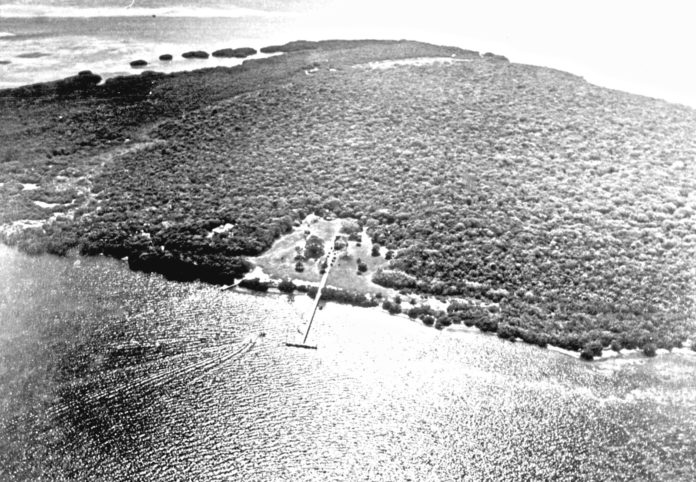Spoiler alert: the Florida Keys are a low-lying collection of islands that rises, on average, 3.2 feet above sea level. Three islands, however, boast a peak elevation of 18 feet. Solares Hill, the highest point on Key West and home to the Key West Cemetery, stands at 18 feet, as does a point on Islamorada’s Windley Key. Lignumvitae Key, too, has a place that reaches a peak elevation of 18 feet.
Only a handful of the approximately 1,700 islands making up the Florida Keys archipelago were linked to the mainland by the Key West Extension of Henry Flagler’s Florida East Coast Railway or the wood, concrete and asphalt of the Overseas Highway. When people talk about or write about the Florida Keys, it is usually about one of the 50 or so islands that have been connected by one conduit or the other. There are thousands of histories grounded on those less-connected Keys, and Lignumvitae Key is home to one of the great often-overlooked Florida Keys stories.
The 280-acre island is in the Islamorada area of the Upper Keys, and even though it is visible from the Overseas Highway, it is also one of those islands that are super easy to drive by without even taking notice. The island can be seen in Florida Bay from the slightly arched vantage point of the Indian Key Bridge at about Mile Marker 77.5. Out in the bay, Lignumvitae Key appears as just another low-lying mangrove island. It is located about a mile from the highway.
One of the distractions that make it easy to overlook the island comes in the form of the iconic Alligator Reef Lighthouse standing on its iron, skeletal legs out on the Atlantic horizon. It also does not help that while driving from Upper Matecumbe to Lower Matecumbe Key and rolling gently up and over the Indian Key Bridge, colorful Robbie’s Marina presents itself as one of the last of the great roadside attractions. It is an absolute eye-catcher.
Lignumvitae Key was historically overlooked because the relative shallows surrounding the island made for a difficult approach for the cumbersome ships sailed by European explorers. However, the island was not completely ignored. For all the history connected to the island, Lignumvitae Key has managed to retain much of its integrity. Unlike many of the other islands of the Florida Keys, especially those that were connected by the train or the highway, Lignumvitae Key is still forested by a virgin sub-tropical hammock.
The island is named after the tree of life, the lignum vitae tree. Like the island, the tree has a remarkable history. Stories say that the lignum vitae tree grew in the Garden of Eden and that the Holy Grail was carved from its wood. The tree produces an exceedingly dense wood that is not only strong but considered relatively inflammable as far as wood goes. Chipped up and muddled, the wood of the lignum vitae tree has an impressive list of curative properties. Not only was it used to cure syphilis, but its pharmaceutical counterparts range from Xanax to Viagra.
Lignum vitae trees grow thick on the island that was once called Cayo de la Lena, or Firewood Key, on an unnamed 1769 Spanish chart. English cartographer Bernard Romans identified the island as Lignum Vitae Kay on his 1774 chart, and the name has, for the most part, stuck ever since. The island, known as Lignumvitae Key Botanical State Park today, is another example of what Florida does best: set aside land for its park system.
The island’s earliest explorers were the people known as the Matecumbe culture of Indians. Evidence of their interaction with the island comes in the form of a rarity in the Florida Keys, a prehistoric Indian burial mound. There are stories passed around about the burial mound that are astonishing. People say the bones of a Calusa Indian who stood more than 8 feet tall were buried on the island, though none of the bones discovered within the mound fit the bill of that alleged account.
Stories of these giant people are bandied about on the outskirts of historical research. It is crucial to remember that while the aboriginal people of South Florida and the Keys stood taller than Europe’s explorers, they were not giants. Hundreds of years ago, the average height of the European male was about 5 feet 5 inches tall, whereas the average aboriginal male stood closer to 6 feet tall.
The prehistoric teardrop-shaped sand burial mound discovered on Lignumvitae Key covers approximately 200 square feet and rises to an elevation of 3 to 4 feet. Human bones were discovered around the site and about 7 inches below the surface. Carbon dating of a skull taken from the mound revealed it to be about 1,800 years old. Other bones uncovered in the mound were dated between 800 to 1,400 years old.
The Indians were not the last to use the island. In next week’s column, we will explore more history of Lignumvitae Key Botanical State Park and its connection to Indian Key Historic State Park. Stay tuned.



















